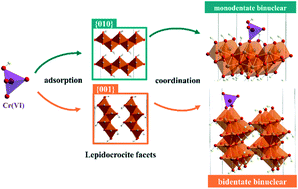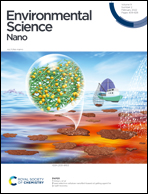Molecular-scale study of Cr(vi) adsorption onto lepidocrocite facets by EXAFS, in situ ATR-FTIR, theoretical frequency calculations and DFT+U techniques†
Abstract
Lepidocrocite, as a ubiquitous iron mineral, is widely detected in different morphologies in natural environments, controlling the mobility and availability of heavy metal ions (HMIs). These different morphologies of lepidocrocite commonly exhibit different surface reactivities due to its exposed facets. However, the adsorption mechanism of HMIs onto lepidocrocite facets remains ambiguous. In this study, Cr(VI) adsorption on lepidocrocite with different exposed facets was investigated via macroscopic batch experiments, synchrotron-based X-ray absorption fine structure (XAFS) spectroscopy, in situ ATR-FTIR spectroscopy, and density functional theory (DFT) calculations. Macroscopic experimental results showed that the maximum Cr(VI) adsorption capacity for rod-like lepidocrocite with a higher proportion of {001}/{010} (R-LEP) was 0.137 mg m−2, 2.21 times higher than that of plate-like lepidocrocite (P-LEP). Meanwhile, the Cr(VI) site density on the {001} facet was estimated to be 4.30 #Cr nm−2, much higher than that on the {010} facets (0.42 #Cr nm−2). The fitting results of EXAFS spectroscopy revealed that Cr(VI) coordinated to the surfaces of P-LEP and R-LEP via the formation of both bidentate and monodentate inner-sphere complexes. In situ ATR-FTIR spectroscopy combined with theoretical frequency calculations showed that two Cr(VI) species formed in different relative proportions on P-LEP and R-LEP, the bidentate binuclear complex was the dominant species on the {001} facets, and the protonated monodentate binuclear configuration formed on the {010} facets. DFT+U calculations further confirmed that the two Cr(VI) surface structures on their corresponding facets both exhibited high thermodynamic stability. This study will help to understand the roles of lepidocrocite in mobilization of HMIs in environments and provide guidance to design an efficient adsorbent for environmental remediation.

- This article is part of the themed collection: Environmental fate of nanomaterials


 Please wait while we load your content...
Please wait while we load your content...